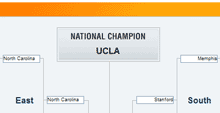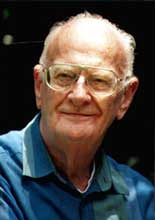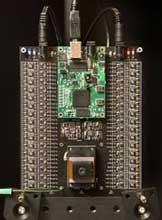 It is that time again, the Ides of March, the time for - ta da - March Madness! Otherwise known as the Tivo-a-thon. For the next four days, I will eat, sleep, and work while watching 48 basketball games. How it was ever done before Tivo I don't remember (VHS tape?). Anyway yes Aperio has a pool (we are raising money for cancer!) and yes I have filled in my bracket and yes you can see it; just click the excerpt at left. And yes, I am picking UCLA to go all the way. Go Bruins! It is that time again, the Ides of March, the time for - ta da - March Madness! Otherwise known as the Tivo-a-thon. For the next four days, I will eat, sleep, and work while watching 48 basketball games. How it was ever done before Tivo I don't remember (VHS tape?). Anyway yes Aperio has a pool (we are raising money for cancer!) and yes I have filled in my bracket and yes you can see it; just click the excerpt at left. And yes, I am picking UCLA to go all the way. Go Bruins! 
 Wow, so Arthur C. Clarke has died, at 90, in Sri Lanka. Of course when we think of him we all think of 2001: A Space Odyssey, but did you know he was the first to propose geostationary satellites as communication relays, in 1945? To this day geostationary orbits are sometimes called Clarke orbits. Wow, so Arthur C. Clarke has died, at 90, in Sri Lanka. Of course when we think of him we all think of 2001: A Space Odyssey, but did you know he was the first to propose geostationary satellites as communication relays, in 1945? To this day geostationary orbits are sometimes called Clarke orbits. 
I totally love this: so at Geno's Steaks in Philadelphia there's this sign: "This is America: when ordering please speak English." The Commission on Human Relations (whatever that is) recently ruled these signs do not violate the city's Fair Practices Ordinance. Well I should hope not! This is a free country, and what's more, our language is English. 
I wish this would start a trend, for example: "This is America, when voting please use English", or how about this one: "This is America, when learning in school please use English". I know it won't happen, but I can wish...
Steven Frank on niches in a market: The First, the Free, and the Good. "Where you can really dominate is by combining two or more of these properties. If you are first AND best, you'll be doing quite well for a very long time, as long as you stay the best. If you're the best and free, it's going to be very hard to compete with you -- although those two lines don't intersect just every day." I like First and Best. Free, not so much. Yeah I know you can make money with Free, but it isn't easy. [ via John Gruber ] 
 This is amazing: Stanford researchers cram 12,616 tiny lenses into a 3D camera. "A team at Stanford is working on a 3D camera that uses 12,616 micro-lenses to generate high quality 3 megapixel images with self-contained 'depth maps' that measure the distance to every object in the frame. The system works by focusing each lens above four different overlapping sensor arrays, which work in concert to determine depth -- just like your eyes." I guess the output is an image you can rotate to view at any angle. This is amazing: Stanford researchers cram 12,616 tiny lenses into a 3D camera. "A team at Stanford is working on a 3D camera that uses 12,616 micro-lenses to generate high quality 3 megapixel images with self-contained 'depth maps' that measure the distance to every object in the frame. The system works by focusing each lens above four different overlapping sensor arrays, which work in concert to determine depth -- just like your eyes." I guess the output is an image you can rotate to view at any angle. 
 Finally, here we have a wonderful picture of an Angel Oak, in South Carolina. Wow, that's just about all I can say. (Please click pic to enlarge.) Finally, here we have a wonderful picture of an Angel Oak, in South Carolina. Wow, that's just about all I can say. (Please click pic to enlarge.) 
| 



